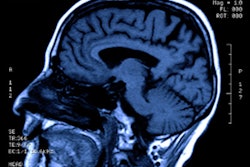
In the high-stakes world of professional and elite amateur sports, medical imaging has a vital role to play, according to a presentation on January 24 at the Total Radiology Conference at Arab Health 2022 in Dubai.
 Dr. Amanda Isaac. Image courtesy of Robert Stevens.
Dr. Amanda Isaac. Image courtesy of Robert Stevens.Sports imaging is quite different from day-to-day hospital medicine and encompasses a variety of indications, including assessment of players for potential new clubs, as well as evaluating acute injuries, performing body composition analysis, and even screening for COVID-19-related myocarditis, according to Dr. Amanda Isaac, a consultant musculoskeletal radiologist at Guy's and St. Thomas' NHS Foundation Trust in London, U.K.
Isaac has dual certifications in both orthopedics and radiology, and she is involved in the care of a few soccer clubs in the Premier League, the most competitive league in the U.K.
In sports imaging, confidentiality and collaboration is very important, Isaac said.
"In order to do sports medicine, it's very important to work with like-minded colleagues and integrate our knowledge together, as the evidence that we generate is constantly evolving and that affects the way we approach different conditions and manage patient care," she said.
These patients also tend to have multiple stakeholders involved in their decision-making process, such as their psychologist, dietician, well-being manager, agent, coach, family, and team captain, she said.
These stakeholders will be asking for specifics about the pathology and how it's going to be managed, she said.
Different scans
Imaging protocols are also quite different from hospital patients, according to Isaac.
"We tend to do a bit more of 3D sequences, as these enable us to look at finer structures," she said.
For example, 3-tesla MRI is preferred over 1.5-tesla scanners due to the increased resolution of the more powerful scanners, she said.
Isaac is involved in the sports subcommittee of the European Society of Musculoskeletal Radiology (ESSR), which has published a number of guidelines for imaging protocols for MRI of sports injuries. There are also specific scenarios with specific protocols that are included in a recent book published by the ESSR sports subcommittee in June 2021.
Imaging of transfers
In addition, there are various indications for imaging in sports fields, including assessment of players who are potential transfers for new clubs by or qualifiers to national teams.
"Most of these players have a passport, which includes older medical imaging from previous injuries," she said. "But there is sometimes a little bit of reluctance for sharing it as that is directly linked to the market value of the player. So it's important to go through everything consistently and objectively before we issue our reports."
It's also important to see if the patient has had any follow-up imaging, as just documenting an injury in itself is not as relevant as documenting the healing process, according to Isaac.
A head-to-toe approach is taken in these assessments, followed by imaging of specific areas that need to be focused on.
"And we try to do an abridged imaging protocol, because otherwise the player would be in the MRI scanner for many days," she said. "And we prefer to be in the room when they're clinically examining them so that we directly perform the imaging that's required to be done and do it effectively."
It's also vital to have clear communication with the team doctor and be very clear in the reporting of the imaging studies, as these results directly translate to the decision of whether the player will be able to join a new club or go to the Olympics and represent their country, according to Isaac.
"The stakes are quite high," she said. "There's also a lot of press exposure, so you have to maintain confidentiality."
Acute injuries
In an acute setting, it's important to see the mechanism of the injury and the mechanics, as that directly links to what will be seen on the imaging, she said.
"We can do immediate imaging, and that's usually ultrasounds, unless you're worried about concussion or a bleed," she said. "Then we'll do a MRI of the brain and a CT, but otherwise, we usually prefer to wait for a few days until the swelling subsides to enable us to see the structures a bit better."
Multimodality imaging is utilized in acute injuries. It's important in these acute cases to be very specific in conveying imaging findings and avoid ambiguous findings, she said. It's also important to rely on internationally validated classification guidelines, such as the British Athletics muscle injury classification system.
She noted that a multidisciplinary assessment is used to decide when a player is ready to return to play.
"We work quite closely with the doctors of the teams and the physios in order to see what the healing process is, but this is not just based on imaging," she said. "So you have to include the player whether he's ready to go back on the pitch or what games they're playing next."
A lot of imaging is performed to arrive at these assessments, according to Isaac.
"So we do a lot of repeated imaging, and that means that we need to adopt low- or no-radiation dose modalities where possible, because the player in their lifetime will have a lot of imaging compared to you and I," she said.
When performing follow-up imaging, it's also important to marry up the imaging protocols with the original imaging studies that documented the injury, Isaac said. This enables accurate assessment of change.
"Whenever possible, use qualitative and quantitative assessments because players like numbers; they understand them well," she said. "And they're able to respond better when you're trying to encourage them to do the rehab or return to play when they're reluctant."
COVID assessment
Sports imaging is also performed for other conditions most commonly now for COVID-19 and long-COVID assessment.
"Most recently we worry about COVID-19 myocarditis, which has, we think, also contributed to the cardiac arrest of some of these players in competitions in 2020 and onwards," she said. "A lot more patients now are offered MRI to screen for myocarditis from COVID."
Body composition analysis is also a big topic in sports imaging, most commonly for assessing bone mineral density, she said. These assessment tools have to be quantitative, accurate, reproducible, and widely available.
Sports applications for body composition analysis include monitoring of performance, disease progression, and treatment monitoring, Isaac said. She noted that artificial intelligence (AI) software can be useful for body composition analysis on whole-body MRI exams acquired on 1.5-tesla MRI scanners.
In addition, sports imaging applications include health screening related to neurology screening, concussion, and postconcussion syndrome. Cardiac screening is also a big topic, especially in the U.K., she said.
As injuries are sport-specific, it benefits the radiologist to have expertise in a specific sport. However, it's also important to work within a multidisciplinary team.
"So don't work in isolation," she said.





















